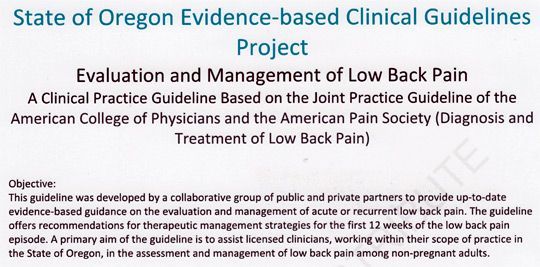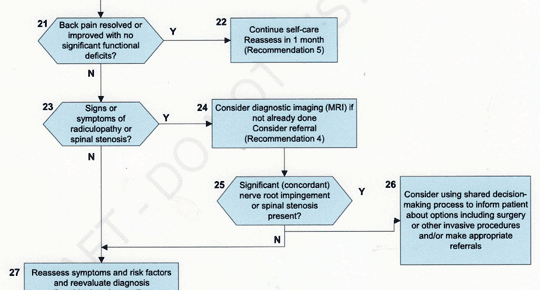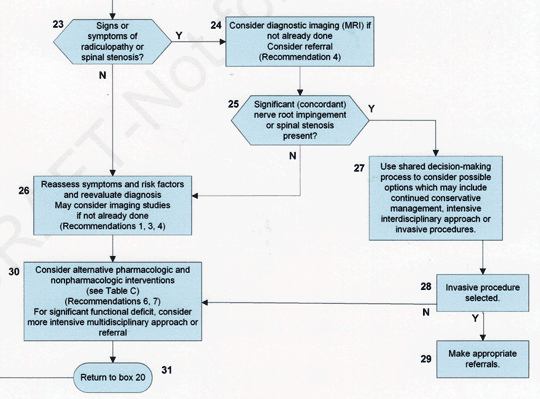New York's highest court of appeals has held that no-fault insurers cannot deny no-fault benefits where they unilaterally determine that a provider has committed misconduct based upon alleged fraudulent conduct. The Court held that this authority belongs solely to state regulators, specifically New York's Board of Regents, which oversees professional licensing and discipline. This follows a similar recent ruling in Florida reported in this publication.
Oregon LBP Guidelines: Try Chiropractic First
The new State of Oregon Evidence-Based Clinical Guidelines for the Evaluation and Management of Low Back Pain recommend spinal manipulation as the only nonpharmacological treatment for acute lower back pain. (Image 1) The guidelines, which have been adopted by the Oregon Health Authority, are a collaborative effort between the Center for Evidence-Based Practice, Oregon Corporation for Health Care Quality, Oregon Health and Sciences University's Center for Evidence-based Policy, and the new Oregon Health Evidence Review Commission.
The Oregon Chiropractic Association (OCA) repeatedly gave written and oral testimony that the original draft guidelines placed too much emphasis on drugs and surgery. A close review of the original algorithm, "Management of Low Back Pain (LBP) (Image 2), relative to "#23 Signs or symptoms of radiculopathy or spinal stenosis," reveals this. For example, if subsequent special imaging (MRI) revealed concordant nerve root impingement or spinal stenosis (#25), the original draft algorithm led the clinician into a surgical or other invasive procedure "dead end," meaning there was no contingency for conservative chiropractic treatment (#26).

The OCA responded with this author providing fellow Health Evidence Review Commission members with scientific clinical journal articles validating the efficacy of chiropractic spinal manipulation for lumbar radiculopathy and stenosis, with an emphasis on Dr. James Cox's flexion-distraction technique research. Our evidence-based input resulted in a much-improved final version (Image 3) now recommending "#25 & #27 … continued conservative management, intensive interdisciplinary approach," rather than leading medical clinicians down a path which led only to surgery or other invasive procedures.
Next, the OCA gave input relative to the original draft that emphasized pharmacological over non-pharmacological interventions, not the least of which was spinal manipulation. (Image 4) We vehemently opposed the emphasis on drug therapy, citing the considerable downside to all the pharmacology currently in health care. A close look at this original draft chart's far left column reveals that after the listed "Self-care," the chart originally listed "Pharmacologic therapy" ahead of "Nonpharmacologic therapy." Following our input, the chart was significantly changed, placing nonpharmacologic therapy ahead of pharmacologic therapy, with an additional note of the greater risk for NSAIDs, benzodiazepines, and opioids. (Image 5)
We made our suggestions in consideration of the risk versus benefit favoring spinal manipulation over the use of pharmacologic therapy including "first-line medications," e.g., acetaminophen or non-steroidal anti-inflammatory drugs. We referred to the landmark Agency for Health Care Policy and Research (AHCPR) acute low back pain guidelines (1994), which have not been refuted by any subsequent research or guidelines; and which state that spinal manipulation both relieves pain and restores function, while pain medications (NSAIDs and analgesics) relieve pain but do not restore function.





We also pointed out that the risk-to-benefit ratio favored less invasive spinal manipulation over drug therapy, including the recommended first-line medications acetaminophen and NSAIDs, and most certainly over narcotic medications. We did so using the following sobering facts:
Acetaminophen (e.g., Tylenol) is the leading cause of acute liver failure in the United States, resulting in approximately 140,000 poisoning cases, 56,000 ER visits and approximately 100 deaths each year. Oregonians were unknowingly taking more than one product that contained acetaminophen, increasing the likelihood of unintentional overdoses and poisoning. Non-steroidal anti-inflammatory drugs (NSAIDs) are the second leading cause of peptic ulcers, resulting in more than 100,000 hospitalizations at an estimated $2 billion in additional health care costs and 17,000 deaths yearly in the U.S. - NSAID use is also associated with cardiovascular mortality, particularly in the elderly. These associations exist for both COX-2 inhibitors such as Celebrex and non-selective NSAIDs such as ibuprofen and naproxen.
We noted that Oregon's narcotic statistics reveal that between 1997-2007, hydrocodone sales increased by 280 percent, oxycodone by 866 percent and methodone by 1,293 percent, and resulted in 700 poisoning deaths from 2003-2007, with the increasing availability of opioids closely paralleling increased mortality from opioid overdoses.
Fifty-three percent of drug overdoses in Oregon are associated with prescription opioids, an overall increase of 540 percent since 1999 and a 1,500 percent increase in deaths from methodone alone. Prescription drug overdoses account for the most drug-related deaths in Oregon and the opioid methodone is the leading cause of those deaths.
We explained that in regards to increased costs to Oregon's health care system, the number of treatment admissions for opioid use increased 130 percent between 1999-2005. As a consequence, the OCA stood strong stating that for the State of Oregon to recommend the use of dangerous narcotics ahead of proven spinal manipulation conflicts with the stated goals of the Oregon Health Policy Board to "lead Oregon to a more affordable, world-class health care system." To "set standards for safe and effective care" was nonsense. The OCA stood strong for our profession and our patients, demanding that based on the scientific evidence, safer spinal manipulation must be placed in a first-tier status ahead of any recommendations for narcotics.
We are a nation of "pill poppers" and are quickly approaching the 4 billion annual prescription purchase mark, which will result in an estimated annual cost of $500 billion by 2015 when Oregon's universal health care system comes fully online. We explained that this represents only the direct drug costs and does not include the indirect cost of treating consumers who suffer the estimated 2.2 million adverse drug side effects, resulting in over 700,000 ER visits and 1 million hospitalizations each year; nor does it include the economic costs of lost work capacity or lost work days due to these adverse drug events.
We pointed out that recently the Centers for Disease Control and Prevention (CDC) reported that nine out of 10 poisonings are related to the abuse of prescription drugs, 40 percent being related to pain medications alone. We concluded with the reality that chiropractic physicians have a proven track record of providing overall health promotion and wellness while also treating an individual's particular health care needs – without all the harmful synthetic pharmacology.
There are so many evidence-based natural remedies that work and so many drugs that don't; it's time to make a change here in Oregon and the Oregon Chiropractic Association made a difference. I am proud of our state association, which stayed resoundingly true to our philosophy and by so doing changed a significant piece of health care reform here in Oregon.
References
- Acute Low Back Pain Problems in Adults: Assessment and Treatment, Guideline 14. U.S. Agency for Health Care Policy and Research, publication No. 95-0642, December 1994.
- Schilling A, Corey R, Leonard M, Eghtesad B. Acetaminophen: old drug, new warnings. Cleveland Clinic Jol of Med, 2010;77(1):19-27.
- Lanas A, Perez-Aisa MA, Feu F, A nationwide study of mortality associated with hospital admission due to severe gastrointestinal events and those associated with nonsteroidal anti-inflammatory drug use. Am J Gastroenterol, 2005;100:1685-93.
- Frech E, Go M. Treatment and chemoprevention of NSAID-associated gastrointestinal complications. Therapeutics and Clin Risk Manag, 2009:65-73.
- Hochman JS, Shah NR. What price pain relief? Circulation, 2006;113:2868-70.
- Oregon Public Health Division, Dept of Human Services. CD Summary, Sept. 29, 2009.
- Hedberg K. Prescription Opioid Overdose in Oregon: A Public Health Perspective. Oregon Health Authority, 2011.


